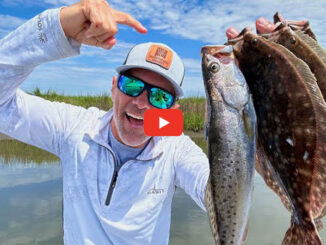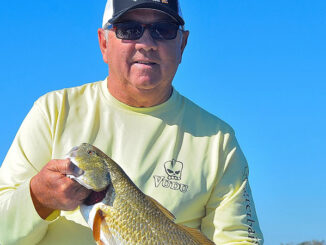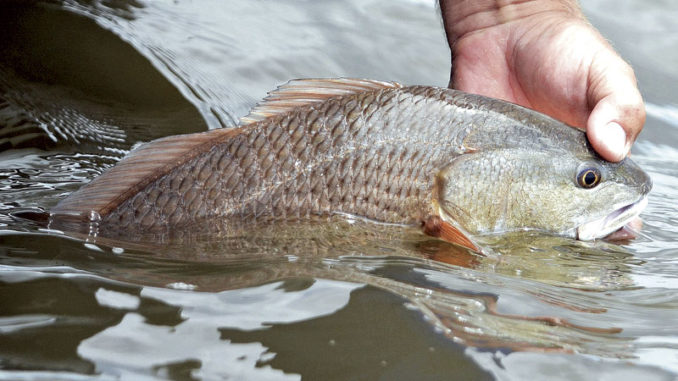
This area’s often-ignored marshes provide anglers a full plate
Most anglers head to Calcasieu Lake south of Lake Charles hoping to catch monster speckled trout, certainly one of the best places in Louisiana to accomplish that goal.
Roughly 12 miles long by nine miles wide and surrounded by flat wetlands, the massive shallow system known locally as Big Lake offers little protection from howling winds. The open waters of the 50,000-acre lake can churn with white-capping waves muddying the water on a breezy day. Fortunately, anglers can find numerous other places in the estuary to catch a cornucopia of both fresh and salty species.
“In the open waters, we can’t fish when we get strong winds,” said Tom Adams, Jr. of Fishing Tom Guide Service, (318-675-9114, www.fishingtom.net) who runs two lodges combined into one in Sulphur. “Most people know Big Lake, but we also fish the marshes and bayous between Big Lake and Sabine Lake.”
The Calcasieu Ship Channel runs 40 miles north from the Gulf of Mexico to Lake Charles, touching Big Lake and other waterbodies in the estuary. Along the way, it bisects the Gulf Intracoastal Waterway. To the west, the GIWW merges into the Sabine River on the Louisiana-Texas line. The Sabine River flows into Sabine Lake, another excellent fishery for giant specks and other species.
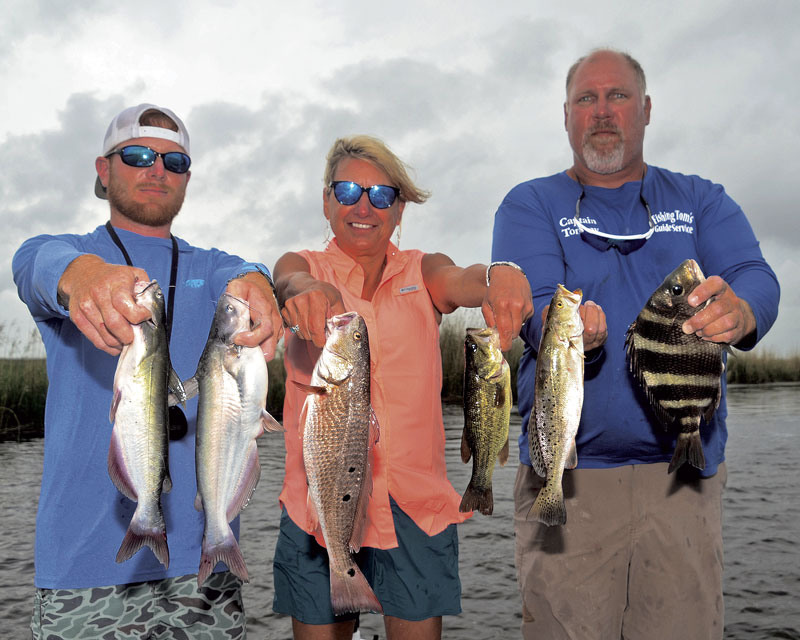
Marshy wilderness
From the GIWW south to the Gulf of Mexico, a vast marshy wilderness beckons anglers between the two major lakes. Sabine National Wildlife Refuge conserves nearly 125,000 acres of the pristine marshland punctuated by numerous impoundments, bayous, canals and ponds. In the marshes between the lakes, anglers can catch anything that swims in fresh or salty Louisiana waters with little competition. Recreational anglers can fish the refuge from March 15 to October 15 each year. The refuge opens for waterfowl hunting during the season. For more on fishing the refuge, see www.fws.gov/refuge/sabine.
“We usually don’t see the boat traffic in those marshes and bayous as someone would see in the two lakes,” Adams commented. “Many different species hang out all together in the same places. It’s not too salty for freshwater species and it’s salty enough for many saltwater species to survive in it.”

Fresh water comes down primarily from the Sabine River into the northwestern portion of the marshes where it mixes with salty water coming up from the Gulf through the Calcasieu Ship Channel. The incredibly blurred demarcation between the two environments blends and moves constantly. This fertile mixing of both sweet and saline worlds creates a piscatorial gumbo hosting a multitude of diverse species feeding upon the same prey.
Largemouth bass can tolerate up to about 10 parts per thousand of salinity. Blue catfish can tolerate salinity better than most other freshwater species. Redfish and flounder can live in pure fresh water. Most other salty species tolerate varying salinity levels.
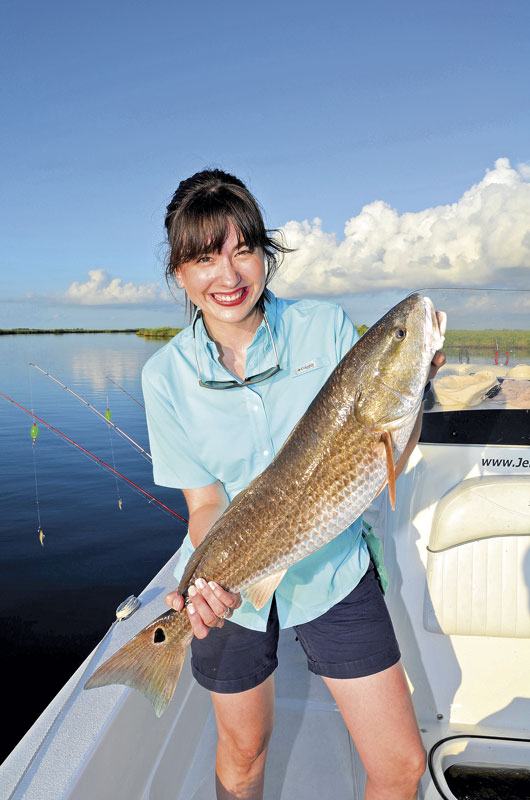
Variety of species
“We routinely catch both saltwater and freshwater species in the marshes,” Adams said. “We might catch 15 or more different species in one day. We use the same techniques to catch all those different species.”
What someone catches in a particular spot on any given day, or even hour, largely depends upon water levels and flow as dictated by tides and wind. Anglers might catch mostly bass from one spot early in the morning, but more redfish and speckled trout later in the day at the same spot, or perhaps land all three together.
Predatory fish, particularly redfish and bass, commonly feast upon the best forage from both worlds, often at the same time and place. They gorge themselves on a rich smorgasbord of sweet species such as shad, shiners, crawfish and sunfish or munch marine morsels like crabs, shrimp, cocahoes, menhaden, mullets, croakers and uncountable other creatures.
“Fishing for redfish is a lot like fishing for bass,” said Stephen Browning, a Bassmaster Classic pro who also fishes for redfish. “Anything a bass will eat, a redfish will eat and vice versa. In brackish water, it’s not unusual to catch bass and redfish on the same lures in the same places.”
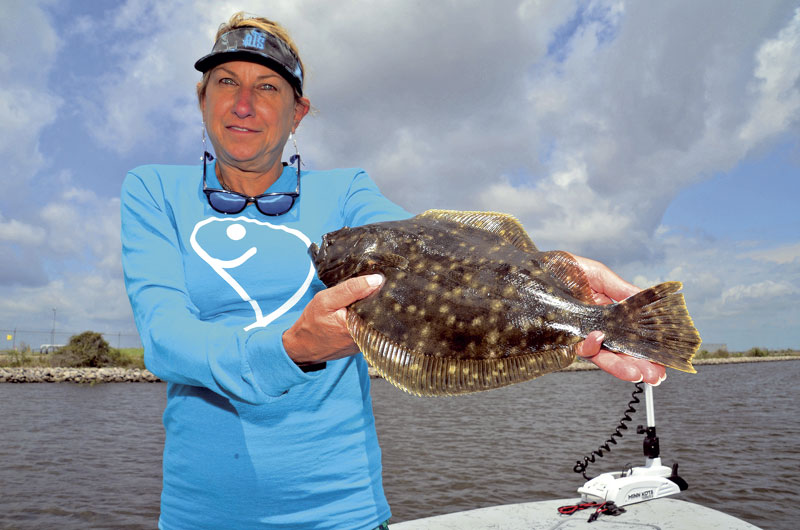
To entice bass and redfish, anglers can use most traditional temptations. Both species frequently hit topwaters, spinnerbaits, bladed jigs, spoons, crankbaits and various natural baits. Anglers also catch them on various soft-plastic attractions. Redfish devour bass jigs sweetened with craw trailers because they mimic crabs. Flounder slurp plastic worms, fished either Texas or wacky style.
In dense grass, throw soft-plastic frogs rigged weightless and weedless. Frogs can go through or over the thickest cover and tend to provoke strikes from larger bass. Although frogs don’t usually show up on a spot-tailed marsh marauder’s daily menu, redfish blow up on buzzing frogs like a grenade detonating in the water.
“Frogs are not on the everyday menu for redfish, but a redfish will eat just about anything,” said Mike Gallo of Angling Adventures of Louisiana (877-4AAOFLA, www.aaofla.com). “If something fits into its mouth, a redfish will eat it.”
Fish sinking frogs with a steady buzzing retrieve to create surface commotion. At open pockets, let the frog sink a foot or two. With floating frogs, let it sit motionless a few moments. Then, pop it vigorously. The commotion simulates a live frog splashing across the surface.
Crustacean migration
Nothing ignites a multi-species feeding frenzy like a crustacean migration. After a good cold snap in the fall, white shrimp leave the estuaries to head for deeper waters. Brown shrimp migrate up from the gulf to the estuaries in the spring. As shrimp move, everything follows because no predator in the marsh will refuse a shrimp snack, including bass. Largemouth will readily attack a live shrimp under a cork or a soft-plastic shrimp imitation.
“Bass absolutely love live shrimp,” Adams said. “Like trout, they want something moving. Most bass in the marsh average about one to two pounds, but anglers specifically targeting bass sometimes catch 5 to 6-pounders. Several bass clubs fish tournaments in that marsh. Some anglers have caught bass in the 8 to 10-pound range.”
On a recent trip with Adams, we caught 13 species, most of them on live shrimp under a popping cork. We also caught some blue and channel catfish, freshwater drum plus several salty species with shrimp on the bottom.
“In September and into the fall, we fish grass lines with live shrimp under a popping cork,” Adams said. “For redfish, I like to work the main bayou shorelines. I look for flowing water. Black Bayou can produce excellent action. It usually has moving water. The bayou averages about eight to 10 feet deep, but some holes drop to 14 feet deep. Redfish like to hang out in the holes as water temperatures cool in the fall. We also catch many flounder in the same places where we catch redfish and bass, especially in the fall. Flounder like a 3-inch Berkley Gulp! Swimming Mullet.”
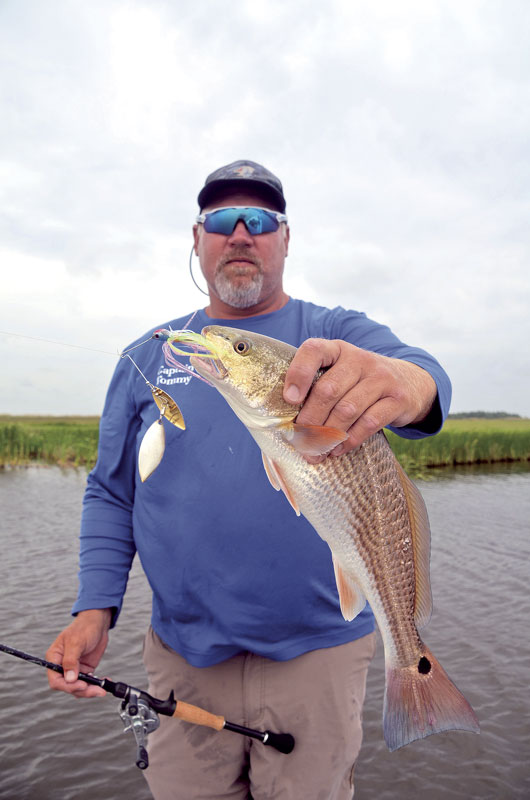
Falling tide dinner bell
During a falling tide, dropping water levels pull baitfish, shrimp and crabs into deeper water. Bass, redfish, flounder and other species wait at the mouths of small drains to ambush anything washing down with the flow. Toss a popping cork as far upstream as possible and let it float down with the current. Pop it periodically to simulate fish striking. Around grassy shorelines, toss the rig against the current so the tide or breeze can carry it over the honey hole.
Anglers can fish a soft-plastic shrimp imitation, such as Vudu, D.O.A. or Gulp! the same way. Also try a shrimp imitation fished with as little weight as possible. If necessary, add a tiny split-shot for casting distance. As with the cork, let the current carry the bait naturally. Add just enough action to keep the bait suspended in the flowing water. Use the reel only to take in slack. Reds, trout, flounder and bass will hit such an enticement.
“Trout action depends largely on salinity levels,” Adams said. “We usually find specks closer to Sabine Lake. In the marshes, trout average about 12 to 15 inches long, but it’s not uncommon to catch a limit of 15-inch trout, especially in the fall.”
Besides the Black Bayou area, anglers can also fish the Vinton Drainage Ditch, which crosses the Intracoastal and merges into Black Bayou. The East Cut connects the north end of Sabine Lake to Black Bayou. Anglers can also fish several pockets and cuts along the GIWW.
Closer to the Calcasieu side of the marsh, the Black Lake area produces great fishing action for salty species. The Salt Ditch runs from the GIWW to the Black Lake area and regularly produces good trout action. Kelso Bayou connects Black Lake to the Calcasieu Ship Channel. People can also fish off the bank along Highway 27.
“The waters around Black Lake are very good for redfish, trout, flounder and other saltwater species,” Adams said. “In the marshes, we never know what might grab the line, especially when we put a live shrimp on a hook. It’s always a surprise what we bring in. That’s what makes fishing this area so exciting!”
For area information, contact the Visit Lake Charles at 337-502-4358 or see www.visitlakecharles.org.
